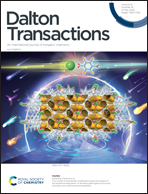The effect of halogenation of salicylaldehyde on the antiproliferative activities of {Δ/Λ-[Ru(bpy)2(X,Y-sal)]BF4} complexes†
Abstract
Ru(II) polypyridyl complexes are widely used in biological fields, due to their physico-chemical and photophysical properties. In this paper, a series of new chiral Ru(II) polypyridyl complexes (1–5) with the general formula {Δ/Λ-[Ru(bpy)2(X,Y-sal)]BF4} (bpy = 2,2′-bipyridyl; X,Y-sal = 5-bromosalicylaldehyde (1), 3,5-dibromosalicylaldehyde (2), 5-chlorosalicylaldehyde (3), 3,5-dichlorosalicylaldehyde (4) and 3-bromo-5-chlorosalicylaldehy (5)) were synthesized and characterized by elemental analysis, FT-IR, and 1H/13C NMR spectroscopy. Also, the structures of complexes 1 and 5 were determined by X-ray crystallography; these results showed that the central Ru atom adopts a distorted octahedral coordination sphere with two bpy and one halogen-substituted salicylaldehyde. DFT and TD-DFT calculations have been performed to explain the excited states of these complexes. The singlet states with higher oscillator strength are correlated with the absorption signals and are mainly described as 1MLCT from the ruthenium centre to the bpy ligands. The lowest triplet states (T1) are described as 3MLCT from the ruthenium center to the salicylaldehyde ligand. The theoretical results are in good agreement with the observed unstructured band at around 520 nm for complexes 2, 4 and 5. Biological studies on human cancer cells revealed that dihalogenated ligands endow the Ru(II) complexes with enhanced cytotoxicity compared to monohalogenated ligands. In addition, as far as the type of halogen is concerned, bromine is the halogen that provides the highest cytotoxicity to the synthesized complexes. All complexes induce cell cycle arrest in G0/G1 and apoptosis, but only complexes bearing Br are able to provoke an increase in intracellular ROS levels and mitochondrial dysfunction.
![Graphical abstract: The effect of halogenation of salicylaldehyde on the antiproliferative activities of {Δ/Λ-[Ru(bpy)2(X,Y-sal)]BF4} complexes](/en/Image/Get?imageInfo.ImageType=GA&imageInfo.ImageIdentifier.ManuscriptID=D2DT00401A&imageInfo.ImageIdentifier.Year=2022)


 Please wait while we load your content...
Please wait while we load your content...